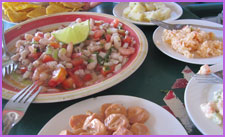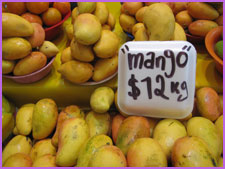
Snacks are called Botanas
In this part of Mexico, there is a strange and lovely tradition of snacking while drinking. The snacks are called botanas, and there are many restaurants that feature botanas in the afternoons and early evenings. What is strange about this tradition? Botanas are free! Walk into a place that serves botanas and order a drink… maybe a refreshing michelada (beer, limone juice, pepper and Worcestershire sauce) or a minty mojito. And then sit back and watch!
What is strange about this tradition? Botanas are free! Walk into a place that serves botanas and order a drink… maybe a refreshing michelada (beer, limone juice, pepper and Worcestershire sauce) or a minty mojito. And then sit back and watch!
The waiter will bring you five or six small plates of botanas, with accompanying tortilla chips (called totopos). The plates will have small portions of ceviche, guacamole, hot dogs with beans, spaghetti… whatever the chef is cooking up. Keep ordering drinks and the botanas will keep coming. You can ask for specific ones, or ask not to bring back ones you don’t like. As long as you are drinking, you can keep eating. What could be better than that?
Local Fruits and Vegetables
If you come from the Great White North (and so many of our visitors do…), you’ll notice the difference in the fruits and vegetables that are available almost immediately. Tropical fruits that are difficult to get and expensive to buy in other parts of the world are inexpensive and plentiful here. Have your fill of different types of mangoes, papayas, pineapples and bananas. You might even feel adventurous enough to try pitayas (dragonfruit), zapote, mamay and other fruits that you have likely never heard of. Oranges and fresh orange juice are everywhere, and so is the local bitter orange (naranja agria), which is used in many Yucatecan recipes. Watermelons and canteloupe melons are easy to come by, and make some of the most delicious aguas frescas, literally ‘fresh waters’ made with fruit juice and water (and usually sugar).
Tropical fruits that are difficult to get and expensive to buy in other parts of the world are inexpensive and plentiful here. Have your fill of different types of mangoes, papayas, pineapples and bananas. You might even feel adventurous enough to try pitayas (dragonfruit), zapote, mamay and other fruits that you have likely never heard of. Oranges and fresh orange juice are everywhere, and so is the local bitter orange (naranja agria), which is used in many Yucatecan recipes. Watermelons and canteloupe melons are easy to come by, and make some of the most delicious aguas frescas, literally ‘fresh waters’ made with fruit juice and water (and usually sugar).
In the vegetable category, the most accessible vegetables are tomatoes, onions, chiles and peppers of all kinds, and potatoes. Winter vegetables like broccoli or cauliflower are not eaten much here. Corn is in almost every meal in one way or another (usually in the tortillas), but corn on the
 cob is virtually unknown here. They just don’t grow that kind of corn in southern Mexico. You may not find spinach, but there is plenty of chaya, a spinach-like leaf that is just as full of nutrients and grows wild here.
cob is virtually unknown here. They just don’t grow that kind of corn in southern Mexico. You may not find spinach, but there is plenty of chaya, a spinach-like leaf that is just as full of nutrients and grows wild here.
Beans here are mostly black beans, but other kinds of beans from other parts of Mexico are easy to come by. Salads are becoming more common, especially in tourist areas, but salads are not a part of the indigenous diet here. Shredded lettuce or cabbage might find its way into a dish, but salads as a dish in itself is not common. There are vegetarian dishes that are common in the Yucatan Peninsula. One in particular is called papadzules, and is made with tomatoes, epazote (a local green that is known for combating parasites) and ground pumpkin seed meal.

Main Dishes are called Entradas
In this part of Mexico (well, let’s face it… all over Mexico), they love their meat. Most main dishes feature either pork, chicken or turkey. Less common are beef dishes, and venison dishes are a traditional treat. Chicken or turkey is present in many of the favorite meals, including panuchos, salbutes and other taco-based meals, and pavo en relleno negro (turkey in a black burnt chile sauce). Pork is the basic ingredient for one of the area’s most famous dishes, cochinita pibil, as well as poc chuc (thinly-sliced pork chops) and lomitos (boneless pork chops).
Another favorite, especially here on the Riviera Maya, is fish. Local fish include grouper or jack fish. The fresh catch of the day can be prepared in many different ways, but probably the favorites are pescado frito (fried, often whole), ceviche (raw fish cooked in lime juice with onions and tomatoes) and tikinxic (fresh fish steamed in banana leaves with achiote paste, tomatoes, epazote, chiles, onions and the local bitter orange).

Of course, no meal would be complete without an accompanying salsa (sauce), and the local cuisine has plenty of those! Salsa habanero is ubiquitous, made from locally grown habanero chiles (some of the hottest in the world) chopped fine and mixed with the juice of limones (limes). Another famous salsa is the cebolla morada, pink onions soaked in the juice of naranja agria. Those pretty pink onions look beautiful on top of many local dishes and add a fresh kick to many meat dishes. Another local salsa is called x’ni pek (Maya for dog’s nose… because it makes your nose run like a dog’s). X’ni pek is made of chopped onions, tomatoes and habaneros with a touch of cilantro in the sauce of those bitter oranges.
Desserts are called Postres
Traditional desserts in the Yucatan start with flan, a traditional dessert in all of Mexico. But here, we also have Dulce de Papaya, a candied papaya dish, Caballeros Pobres (Poor Cowboys), a local kind of bread pudding with raisins, and many flavors of locally-made ice cream. The ice cream made fresh here is light and airy, and flavored with everything from mamay and coconut to avocado or corn.
You also might enjoy a great dessert liqueur that is made locally called Xtabentun. Xtabentun is made from anise and honey, and is a sweeter, smoother version of Italy’s sambuca. Of course, there is no shortage of tequila and mezcal for before, after or during your meal. Andale! Enjoy the great eating in Yucatan… you’re on vacation!

